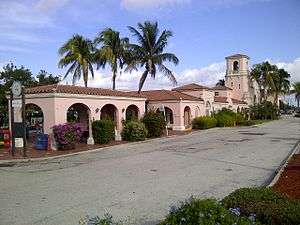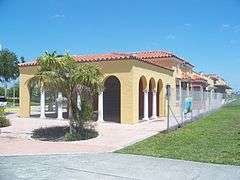Seaboard-All Florida Railway
 The Orange Blossom Special arriving in Fort Lauderdale in 1927 | |
| Locale | East and West Coasts of Florida |
|---|---|
| Successor | Seaboard Air Line Railroad |
| Track gauge | 4 ft 8 1⁄2 in (1,435 mm) standard gauge |
The Seaboard-All Florida Railway was a subsidiary of the Seaboard Air Line Railroad that oversaw two major extensions of the system in the early 1920s to southern Florida on each coast during the land boom. One line extended the Seaboard’s tracks on the east coast from West Palm Beach down to Miami (and later, Homestead), while the other extension on the west coast extended the tracks from Fort Ogden south to Fort Myers and Naples, with branches from Fort Myers to LaBelle and Punta Rassa. These two extensions were heavily championed by Seaboard president S. Davies Warfield (who died months after its completion), and were constructed by Foley Brothers railroad contractors. Both extensions also allowed the Seaboard to better compete with the Florida East Coast Railway and the Atlantic Coast Line Railroad, who already served the lower east and west coasts of Florida respectively. Today, only the east coast route survives, though a few related structures from the abandoned west coast line still stand.
Grand Opening Celebration

The Seaboard All-Florida Railway's west coast route commenced operation on January 7, 1927, and the east coast route began service the following day. On each opening day, President S. Davies Warfield rode aboard a special section of the Seaboard's Orange Blossom Special with a number of special guests and dignitaries including Florida Governor John W. Martin. The train stopped at points along the lines for public ovation with nearly 20,000 people attending. The two-day celebration is considered to be one of the largest public relations events in the history of American railroads.[1][2]
East Coast

The east coast route began in West Palm Beach at the terminus of the Seaboard Air Line Railroad’s recently completed Florida Western and Northern Railroad which originated at the Seaboard main line in Coleman. From West Palm Beach, the extension proceeded south, paralleling the Florida East Coast Railway which operated a short distance closer to the coast, through Delray Beach, Boca Raton, and Fort Lauderdale.
South of Fort Lauderdale, the line shifted farther inland, passing through Opa-locka, and Hialeah and then southeast into Miami, terminating in the Allapattah neighborhood where the original Miami passenger depot was built at 2206 NW 7th Ave.[3][4][5] A later extension branched off the line in Hialeah (near Miami International Airport) southwest towards Homestead.[6] Some of the Homestead extension was realigned in the 1960s to accommodate the expansion of Miami International Airport.
| Seaboard-All Florida Railway (East Coast Route) (CSX's Miami/Homestead Subdivisions) | |||||||||||||||||||||||||||||||||||||||||||||||||||||||||||||||||||||||||||||||||||||||||||||||||||||||||||||||||||||||||||||||||||||||||
|---|---|---|---|---|---|---|---|---|---|---|---|---|---|---|---|---|---|---|---|---|---|---|---|---|---|---|---|---|---|---|---|---|---|---|---|---|---|---|---|---|---|---|---|---|---|---|---|---|---|---|---|---|---|---|---|---|---|---|---|---|---|---|---|---|---|---|---|---|---|---|---|---|---|---|---|---|---|---|---|---|---|---|---|---|---|---|---|---|---|---|---|---|---|---|---|---|---|---|---|---|---|---|---|---|---|---|---|---|---|---|---|---|---|---|---|---|---|---|---|---|---|---|---|---|---|---|---|---|---|---|---|---|---|---|---|---|---|
Legend
| |||||||||||||||||||||||||||||||||||||||||||||||||||||||||||||||||||||||||||||||||||||||||||||||||||||||||||||||||||||||||||||||||||||||||

In more recent history, the Florida Department of Transportation purchased the east coast line from West Palm Beach to Miami International Airport from CSX Transportation (Seaboard's corporate successor through various mergers) in 1988, and is today the South Florida Rail Corridor. FDOT bought the line, which closely parallels Interstate 95, to establish Tri-Rail, South Florida's commuter rail service, after an unsuccessful attempt to establish it on the Florida East Coast Railway. FDOT maintains the line and provides dispatching, while CSX continues to have freight trackage rights (which they refer to as their Miami Subdivision).[7][8] CSX still owns the line south of the airport (at Oleander Junction) to Homestead, which is their Homestead Subdivision. Amtrak also operates the Silver Meteor and Silver Star service from New York City to Miami over the line, both of which are former Seaboard passenger services.
Today, the original 1920s Seaboard stations are used by Amtrak and Tri-Rail for service at West Palm Beach, Deerfield Beach, Fort Lauderdale and Hollywood. Though no longer in use, the Seaboard stations at Delray Beach, Opa-locka, Hialeah, and Homestead are still standing.
West Coast
The west coast route began in Fort Ogden, branching off of the Seaboard's recently acquired Charlotte Harbor and Northern Railway, and proceeded directly south in a nearly straight trajectory to Fort Myers. Some of the former right of way is now a dirt road through the Fred C. Babcock/Cecil M. Webb Wildlife Management Area in southeastern Charlotte County. As the line approached Fort Myers, it crossed the Caloosahatchee River on a long drawbridge just downstream of the original Tamiami Trail Bridge. The pier at Riverside Park in East Fort Myers is located where the bridge crossed the river.
In Fort Myers, the passenger depot (which survives today) was located just south of the river at the intersection of Palm Beach Boulevard (State Road 80) and East Riverside Drive. A separate freight depot (which also survives) was located a short distance south of the passenger depot on Michigan Avenue. Today, Seaboard Street (eastbound State Road 80) travels along the former right of way. From Fort Myers, the line continued south out of the city along Palm Avenue and the west side of the Ten Mile Canal, closely paralleling the Atlantic Coast Line Railroad's competing route (operated today by Seminole Gulf Railway) on the other side of the canal.
At Mullock Creek, another subsidiary, the Naples, Seaboard, and Gulf Railway, continued the line the rest of the way to Naples. From the creek, it headed southeast through Estero (just west of the Koreshan State Historic Site) to Bonita Springs.[9] In Bonita Springs, it turned south again before crossing the Imperial River. A passenger depot existed on the south side of Bonita Beach Road (near the site of First Presbyterian Church).[1] The line then joined the current route of Goodlette-Frank Road near Vanderbilt Beach and headed into downtown Naples, terminating at the Naples passenger depot on Fifth Avenue South. President Warfield had hoped to build a deep-water port in Naples, which was never built. Today, a major FPL overhead power line runs on most the former route from Mullock Creek to just north of Downtown Naples.[9]

In addition to the main route, two branches existed from Fort Myers to LaBelle and Punta Rassa. The thirty-mile LaBelle branch began just south of the Fort Myers freight depot and ran just south of Michigan Avenue before turning northeast and continuing just south of and parallel to State Road 80. It terminated in downtown LaBelle at a depot at Main Street and Seminole Avenue.[10] In the 1940s, a seven-mile spur was built from the LaBelle branch southeast to Buckingham Army Airfield.[11] The 8-mile Punta Rassa branch departed the main line just south of Fort Myers near the Six Mile Cypress Slough. Despite its name, the branch never fully reached Punta Rassa, where President Warfield had also hoped to estsblish a deep-water port. It actually terminated in Truckland near Iona, just two miles short of Punta Rassa. The branch ran from the main route west along the current route of Six Mile Cypress Parkway, through the center of today's Lakes Park, then southwest along the current routes of Summerlin Road and Pine Ridge Road before turning back north slightly to its terminus at McGregor Boulevard in Truckland. The Punta Rassa branch ended up mostly serving agricultural land and gladiolus fields near Biggar.[12] Power line easements run on some of the former right of way of both the Labelle and Punta Rassa Branches.[13]
Unlike the east coast route, the west coast route was not as successful and would exist for less than thirty years. The Seaboard Air Line went bankrupt in 1930 after the collapse of the land boom and discontinued service to Naples in 1942. The southernmost 7 miles of the line from Vanderbilt Beach to downtown Naples and the Naples depot were then purchased by the Atlantic Coast Line Railroad, who connected it to their adjacent line and made it their main route into Naples. This segment would remain in service until 1979.[14] The rest of the west coast route was abandoned and removed by 1952. The Coast Line also reconstructed the first mile and a half of the Punta Rassa branch from their main line in the 1960s to briefly serve a rock mine just east of the Tamiami Trail (US 41) (site of Lakes Park).
Today, a few structures from the line remain. The Naples depot on Fifth Avenue South is now the home of a historical museum. The Fort Myers passenger depot most recently housed the Reilly Brothers Construction company, but the building is currently vacant. The Fort Myers freight depot on Michigan Avenue is now home to Gully's Discount Store Fixtures (the name "Ft. Myers Seaboard Freight Station" is faintly engraved on the side of the building).[14] The John Yarbrough Linear Park also runs near some of the line's former right of way south of Fort Myers next to the Ten Mile Canal.
References
- 1 2 Cottrill, Cathy (December 31, 2013). "Remember: Details sought about the Seaboard Air Line Railroad in Bonita Springs". The Banner. Retrieved 17 May 2014.
- ↑ Turner, Gregg M. (2004). A Milestone Celebration: The Seaboard Railway to Naples and Miami. AuthorHouse. ISBN 9781468517378.
- ↑ "Seaboard Railroad | Flashback Miami". flashbackmiami.com. Retrieved 16 November 2016.
- ↑ "1977 - Old Seaboard Air Line station - Miami Florida". rrpicturearchives.net. Retrieved 16 November 2016.
- ↑ "THE GREAT UNION STATIONS". chicagorailfan.com. Retrieved 16 November 2016.
- ↑ Turner, Gregg M. (2005). Florida Railroads in the 1920s. Arcadia Publishing.
- ↑ "South Florida transportation authority to take over rail corridor operation from CSXT". Progressive Railroading. Retrieved 13 October 2013.
- ↑ http://www.multimodalways.org/docs/railroads/companies/CSX/CSX%20ETTs/CSX%20Jacksonville%20Div%20ETT%20%234%201-1-2005.pdf CSX Jacksonville Division Timetable
- 1 2 "Estero Bay State Park Preserve". MPAtlas. Retrieved 15 November 2014.
- ↑ "National Register of Historic Places Multiple Property Documentation Form" (PDF). National Park Service. United States Department of the Interior. Retrieved 4 November 2015.
- ↑ "MOS 580 — Remote Control Turret Mechanic-Gunner: SGT Floyd Richard McCormick" (PDF). Ancestry.com. Retrieved 11 October 2014.
- ↑ "Seaboard served Ft. Myers from 1926 to 1952". Railroad Museum SWFL. Retrieved 4 November 2015.
- ↑ "History at Hickey's Creek Mitigation Park" (PDF). Lee County Parks and Recreation. Retrieved 15 November 2014.
- 1 2 Turner, Gregg M. (December 1, 1999). Railroads of Southwest Florida. Images of America. Arcadia Publishing.